Comments?
For the basics, see
- Website & Privacy Policies
- How To Get Involved
- The Role of the Park
Search options:
Department Site Map
Custodians:
Newsletter February 2020: special government issue
This newsletter is put out by CELOS, the Centre for Local Research into Public Space. Since 2000, when this little organization began at Dufferin Grove Park, we’ve been doing what we call “theoretical and practical research” into what makes public spaces – like parks – more hospitable and more lively. We’ve been researching what works and what doesn’t, and we’ve documented a lot of what we’ve seen and done, in this newsletter and on our four websites.
Sunday skating-in-the-round returned after January 8
The east lift gate at the rink was fixed pretty fast after all the Tech Services staff got back from their holidays. Now skating in the round on Sundays is back and the skaters are happy.

Dufferin Rink east lift gate, broken in 2013, again in 2019
The remarkable thing is how long the gate was broken without the staff supervisor being told about it. The on-site rink staff said that if anyone complained, they just told them that “the city does its best but the gate can’t be fixed, and people are very understanding.” But they didn’t tell the supervisor the gate was broken! The staff seem to have made the same assumption as this rink friend, who wrote “I didn't bother contacting them. I figured they wouldn't invest the time or money into the last rink season. That will teach me!”
The last time the gate was broken was in 2013. The staff said it couldn’t be fixed then either, but when rink users posed in front of the broken gate and sent the picture to the Parks manager, the gate was fixed. During the holidays, this time, we put the picture up on the fence with the supervisor’s number for people to call, and Erella Ganon put it on the dufferingrovefriends listserv as well. It sounds like only one person called. Canadians are very polite, maybe. Another possibility is that in this booming city there is such a smorgasbord of possible entertainments that when one fun thing doesn’t work, people can just turn their backs and move on to the next fun thing. But that may not work well in the long run.
Why a special “government issue”?
The lift gate apparently broke at the end of last rink season. The length of time before the rink supervisor found out (10 months) -- is disturbing. A general feeling of frustration or distraction may have blocked onsite staff or skaters from moving the news up to where it could be addressed. Since public spaces – like parks – are our neighbourhood treasure (or workplace), it seems like a good moment to look at how government staff – a.k.a. “the bureaucracy” – can be encouraged to make these places work well.
How to register a park problem with our city government
1. Since so few people bother to call, getting any phone calls or emails at all, from the public, can make a big impression on management. Every city staff person can give you their supervisor’s number – they have to, if you specifically ask (nicely of course).
2. Logging a complaint with 311 can help. Their phone message automatically warns callers that they are “experiencing an extremely high volume of calls.” Sometimes they answer right away anyway. Other times they put you on hold and invite you to “select your favourite music genre of music from Toronto artists.” But once you get through, they will take your complaint or question and send it to the relevant city supervisor. That supervisor is supposed to respond to you within two business days, to say whether and when the problem can be fixed. There’s some pressure inside the bureaucracy to actually do this. (Or email: 311@toronto.ca.)
Persistence: how it may have results later
Over the past 25 years park friends and park staff, sometimes under the banner of CELOS, have made many suggestions to parks and rec management that were at first rejected. Some were later on taken up without fanfare. It’s results that matter. Here are four examples:
- eye-level windows in park buildings including rinks. For many decades, windows were a no-no in park buildings, with the exception of reinforced-wire glass doors. The Dufferin Grove rink house had only prison-style high-up windows. In 1998, the local city councillor supported us in getting the city to install four windows at eye-level, despite protest by maintenance staff (because they anticipated window-breaking). Now no new park buildings are built without proper windows. Very few windows are ever broken.
- keeping the outdoor rinks open on holidays: Until about 10 years ago, the downtown rinks were closed on Christmas Day, Boxing Day, and New Year’s Day (except in Etobicoke). The first year of Family Day, the rinks were closed too. Since park friends had the keys to the Dufferin Rink clubhouse, we opened on all holidays anyway. Management didn’t like it, saying they didn’t want to pay city staff the time-and-a-half wages. So we put the word out in the neighbourhood, and local businessman David Rothberg donated the extra funds to cover the wages. He only had to do that once. Now almost all the city’s rinks are open on holidays.
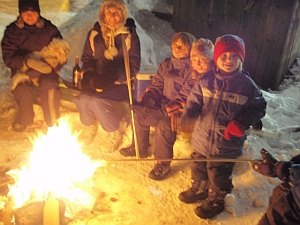
campfires
- campfires were once common in many parks but in the years around amalgamation they were being phased out. Dufferin Grove Park went the other way, making permission easy. But in 2007 a new parks supervisor cancelled the Dufferin Grove campfires. After much local protest, the campfires resumed. Now many other parks have campfire sites as well.
- food in parks was not acceptable to parks management except for private picnics or special events, or at High Park and two high-profile locations on the Lakeshore. Dufferin Grove Park started with the cooking fires, then the outdoor bake ovens, then the farmers’ market (which grew out of the Riverdale Farmers’ Market), then the cob café. There are now eight other parks with ovens, and 11 other park farmers’ markets. (No local park cafés – yet.)
Rink and rink building reconstruction: meeting #11 of the city’s Community Resource Group (CRG), January 16, 2020
In attendance were twelve CRG members: four people for sports (two for bike polo, one for skateboarding, and one for the Thursday Night hockey permit); two for the farmers’ market; one for Clay and Paper Theatre; one for the dufferingrovefriends listserv; and four additional neighbourhood members (three who rarely use the park and one who uses it a lot).
There were also twelve people from the city’s project team: seven city staff, plus one from the councillor’s office, two from the consulting company (Lura), and two from the reconstruction design team (DTAH).
Plus there were two non-CRG members from the neighbourhood.
The presentation: the designers talked about the trees, a green roof (on the garage?), a rainwater drainage course, garden fencing , the location of a hydro transformer, the farmers’ market , the stairs and sloped access paths to the building, the bake ovens, and the construction staging.
Surprises:
(1) the design includes a third outdoor bake oven that no bakers asked for;
(2) the existing wheelchair/stroller access path from the sidewalk to the front door is still going to be there, side by side with a set of new stairs that park friends have asking for since 2003. This access will be duplicated by longer new stairs and another, much longer new access path from the corner – but both of the longer routes will be blocked by snow and ice in winter;
(3) the proposed access for farmers’ market vehicles (for unloading only) will be from the dead end leading up from the Dufferin Street traffic lights to a narrow gap between the reconfigured rinkhouse and the new zamboni garage (i.e. a bottleneck for market trucks);
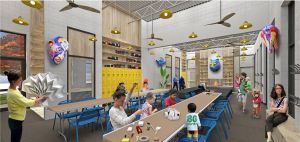
new child care design for interior of former clubhouse
(4) the rink building now has two offices and appears to be laid out as an after-school childcare facility, but there was no comment about this change from a community clubhouse;
(5) the construction schedule says the rink will close in June 2020 and reopen in November 2021 – but that timing depends on construction going on without a hitch right through the winter of 2020/2021.
What is gained:
A new north-south layout for the rink, instead of east-west, with 5 feet extra width
A reconfigured building with offices, designed for a recreation-delivered daycare program
A new plaza for the Thursday farmers’ market
A new bike polo area
What is lost:
The environmental benefits of minimizing new concrete use
The possible savings of $3.5 million (using only $1 million for existing-rink upgrades)
The community drop-in clubhouse, and the park’s history of daily local collaboration
Community consultation: the government version
Way back on Nov.10, 2016, the city hired a community consultation company to help city staff gain community acceptance for replacing Dufferin Rink and the clubhouse. The website of LURA Consulting said it specializes “in both market-based solutions and community-based behaviour change mechanisms.” They helped local city councillor Ana Bailao run a public meeting on the issue on Nov.24, 2016. The project was called a “revitalization” of the park, and many of the people who came to that meeting said that the park was already vital, “don’t fix what’s not broken.” Lura staff emphasized that nothing had been decided yet and that they, the councillor, and city staff were merely there to listen to the community. People were invited to apply to become members of a “Community Resource Group” (CRG) for the project, to give more input, and some signed up. The group met twice in the spring of 2017.
In April 2017, the City of Toronto released a “scope of work” document that described the details of the project. It called for: a new community clubhouse that houses a commercial kitchen, multi-purpose community/recreation room(s), public washrooms, admin/recreation office(s), snack bar, storage room(s), janitorial/laundry room(s), a new outdoor ice rink possibly with a skating trail, refrigeration/mechanical & electrical rooms, a new zamboni garage, and new community gardens and pizza ovens.
At the meetings, it became clear that there was resistance to knocking down the existing rink clubhouse and the ovens, and building them new, and also to replacing the pleasure-skating pad with a trail. So the CRG members were told that the building would be renovated, not replaced, the old ovens would remain, and the new ice rink would have two pads as before. The rest of the “scope of work” stayed the same. The budget for all this, however, was unclear.
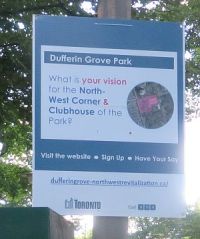
Reno poster
There were no more consultation meetings for a year and a half. When the meetings resumed on October 17, 2018, the CRG members were told that the city had found $4.5 million for the project and had hired a design company. Signs showing a Google satellite image of the area went up all over the park, inviting people to find out more by going to the community consultation website for the project.
On February 6, 2019, another large public meeting was held. The design company presented the first version of their plans. Just like at the first public meeting in 2016, there was considerable skepticism about the merits of doing the project at all. But by now the word was, the project was necessary to “comply with code” and only the design details could be discussed – but fast, because the project was already behind. There was a big staff/designer project team already meeting weekly on a tight schedule – the clock was ticking.
There have been eight more Community Resource Group meetings, plus two more for the public. The plan at the end? It conforms pretty well exactly to the outline that’s been up on the city’s website since 2018, and it’s very close to city staff’s first published plan in 2017.
The Corporation of the City of Toronto
That’s the city’s legal name. Many of the people who work in the city government regard themselves as corporate workers. The corporation recently signed an advertising contract with Publicis, one of the four biggest global advertising and public relations firms, based in France. If the contract goes for its full five years, the city will pay the firm $7.6 million. The city also just signed a contract with Nitsom Promotional Manufacturing, based in China, to supply our city government with logo-ed Tilley hats, baseball caps and toques, presumably to promote its brand by giving out swag. If that contract runs for its full five years, the swag will cost the city $866,501.
That’s okay, the money is there. Our taxes are topped up by development charges from the tall towers going up all over town. The corporate city refers to itself as a business, and – city council agrees – a business needs to advertise itself.
City Hall recently added a Toronto Civic Accelerator Program that “focuses on business partnerships” and hunts for “opportunities through research, program development and the creation of new products and services.” The accelerator also “develops and stewards strategic partnerships with corporate, philanthropic and institutional partners.”
But not, apparently, with the rest of us ordinary people who live here.
We’re the backers of the corporation – we folks who bankroll it through our taxes – but we’re not called shareholders. The city calls us customers. The corporation’s task is to supply us with what we want – roads, buses, trees and places to play sports or run around – and also to protect us – from violence, germs, accidental fires, or rudeness. The list expands every year.
As customers, we’re the clients for the new Customer Experience Transformation and Innovation Program, which is engaged in “developing, supporting and embedding a culture of collaboration and innovation at the City.”
But if we who live here are actually the customers of this business, we need to be given a chance to pick at least some of what we buy. Should the tiles be red or green? Should there be raised beds for seniors to do gardening?
The difficulty with doing community consultations is that a corporation has a payroll, and if the customers decide they don’t want, for example, to spend $4.5 million for the Dufferin Grove Park “revitalization,” that will put staff jobs – the city’s business – in danger. Parks and Rec Capital Projects, which is in charge of building projects in parks, is particularly vulnerable. It meets most of its payroll with a direct percentage of project costs. Between 2014 and 2018, the Parks and Rec capital projects staff payroll amount taken from project costs climbed from $4.2 million a year to $9.1 million. If the Dufferin Rink project cost were to shrink at all, staff would have to be laid off.
So the staff’s stakes in any community consultation are high. The process has to be managed carefully, and professionally. And in the case of the “revitalization project,” it was.
Relating to city hall: some things work, and some things don't
Engaging with our city government can be a bit like a game, sometimes subtle and tricky like chess, sometimes with tough body checking, like hockey. You win some, you lose some.
One of the things that occasionally works well is the Municipal Freedom of Information and Protection of Privacy Act (MFIPPA). It says that you can ask for information that city staff won’t tell you.
Directly: That’s how we got to read the rink engineer’s report to see if it really said the rink slabs were breaking up and needed to be replaced now. (It didn’t.)
Indirectly: the Act says that information that’s not private should be released by city staff when people ask, without making us go through freedom of information. Sometimes staff are worried they’ll get in trouble with their manager if they let you see a report, and it seems easier to just say no. In the case of the pre-2016 city-commissioned studies about the Dufferin Rink and the clubhouse, we said we’d go to Freedom of Information to get them. After some struggle, Capital Projects staff gave them to us directly. Same for our question about evidence-based research by rink management to back up their mandatory helmet policy for pick-up shinny hockey. Terri Jones, the city recreation manager for rinks, checked into it without an FOI request, and it turns out we were right: the policy was made without any evidence.
When questions do need to go through FOI, it’s good to ask for specific documents or specific, short bits of information. Even then, it often takes longer than the 30 days maximum required by the Act, for the city’s FOI office to respond. They’re often swamped, meaning they’re probably under-resourced in the city budget. Stalling for lack of staff resources is against the law, though, according to the Act. We’ll look into that.
What often works: safety in numbers.
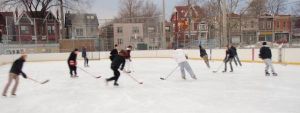
the joy of shinny hockey, Harry Gairey rink
City management has been trying for years to force shinny hockey players to wear helmets at the outdoor rinks, even though the game is non-contact and there is no evidence that shinny is risky in the way full-equipment hockey is. But wherever there are enough people playing drop-in shinny, they have just ignored rink staff’s requests to helmet up. Staff do their duty by quoting the rule, and players do their part by having fun games anyway.
What may not work: petitions
When long-time park friend, gardener and environmental activist Skylar Hill-Jackson found out that mature trees would be removed to make a duplicate access path – and that the concrete rink pads and the basketball court would be demolished and be replaced by new concrete pads facing in a different direction – she contacted some other park friends to get a petition together. Park friends Judy Simutis, Andrea Holtslander, and Toni Corrado helped Skylar collect 1027 signatures against the plan, 726 of them from within 10 blocks of the park.
But the petition was simply disregarded, both by city staff and by Councillor Ana Bailao. Presumably City Hall has learned that many people feel swamped by problems all around, and won’t follow up.
Time will tell how well this project sits with the neighbourhood.
Thursday Feb. 20, 6pm - 8:30, information meeting about the new affordable housing land trust: Bloor Collegiate, 1141 Bloor St. W., in the cafeteria
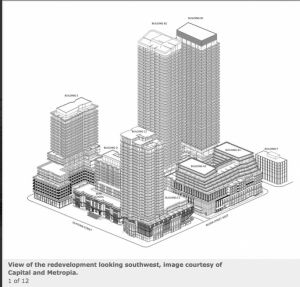
Bloor Dufferin Corner plan, early version
Near the end of last November, the Build a Better Bloor Dufferin (BBBD) community working group had an astonishing bit of news for the neigbourhood. The group had accomplished a very gutsy piece of horse-trading. The BBBD withdrew its objection, at the Ontario Municipal Board, to the Bloor/Dufferin building project’s shortcomings. In exchange, the developers of the former school lands, Capital Developments and Metropia, committed to giving a $9 million donation plus an $8 million interest-free loan for a new nonprofit land trust. It will be led by nonprofit housing providers St. Clare’s Multifaith Housing Society and Habitat for Humanity.
From the BBBD newsletter:
“The land trust will enable nonprofits to acquire land for affordable housing across Toronto and the money itself will multiply as the land trust becomes a magnet for contributions from the City, the provincial and federal governments, other developers, and private foundations. In other words, the $17 million our community secured is likely to double many times over. This will give nonprofits the capacity to compete with private developers for development opportunities. We have made ground-breaking history.”
Now the BBBD working group are inviting people to a Build a Better Bloor Dufferin Neighbourhood Forum. From Emily Paradis:
Come hear updates on the new Bloor Dufferin Land Trust, the redevelopment of the Bloor Collegiate site, the Dufferin Mall development, and other developments in the neighbourhood. Join a BBBD working group and get active for equitable and inclusive development in our neighbourhood! Drop in anytime between 6-8:30. Kids are welcome. Presentation at 7pm. For more info, email info@buildbloordufferin.ca.
Maybe Feb. 22 or 29, fingers crossed: A revival of the bikes on ice event?
From film-maker and ex-bike-courier Nicholas Kovets: “Myself and others in the messenger-biking community would love to restart the dearly missed Ice Bike once again. I am also a local filmmaker who has been documenting the Ice Bike for some years prior to its cancellation a few years ago: vimeo.com/119718851.”
Nicholas has written to the park staff to find out about permits and scheduling. Maybe it will happen! To check on the application’s progress, you can call the park at 416 392-0913.
Clay and Paper Theatre’s winter workshops
When David Anderson read the January newsletter, with its story about Greta Thunberg’s image pasted on a shed wall at the playground, he said that this past summer Clay and Paper made some Greta Thunberg masks for their touring summer production. He sent a photo (posted at the beginning of this newsletter), and also a link to the most recent Clay and Paper Theatre newsletter, here.
The big news right now is two major winter puppetry workshops. The first is already registered and in progress, ending on Feb.12. The second, follow-up workshop is still to come, Feb.22 and 23rd. From their website:
Activate, animate and perform with giant puppets! Explore how to use giant puppets in a theatrical play, a community setting, in parades, or even as part of civil protest. We’ll do a deep dive into movement in this practical workshop, build easy life-size puppets that will help teams of puppeteers to examine the use of breath, focus, weight, listening, specificity and economy of movement. And get a chance to play with Clay and Paper Theatre’s own giant puppets and images integrating new learning into staging and movement possibilities.
More workshop details, including schedule, fees and registration here.
Editor: Jutta Mason/ Illustrations: Jane LowBeer
CELOS websites: dufferinpark.ca, celos.ca, cityrinks.ca, publicbakeovens.ca




 Printer friendly version
Printer friendly version
